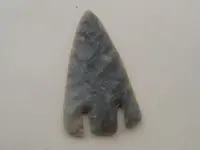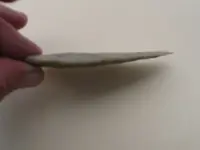The Calf Creek Complex comprises of Calf Creek, Andice and Bell points. However, I dispute many of the "Bell" variants actually belonging to the group. Anyways, that's for another post and time. What ISN'T included as part of the group are the Cossattot River points. However, they should be. They are the predecessors and the earlier Calf Creek points exhibit many of their holdover traits.
For a long time, Perino wouldn't admit to the true Andice occurring up this far north. However, he did change his mind about that quickly after numerous examples found up here in Northern Oklahoma. Unlike some of the more typical Calf examples, northern Andice seem to be almost solely found on, or near, large rivers and waterways.
Ok, What's the difference between typical "Calf Creek" or "Andice?". Your common Calf Creek are typically made on a ovoid preform, while Andice are made from a triangular preform. Both can be very large, and they are usually very well made. Calf Creek stems are parallel to expanding, while Andice go from parallel to contracting (as in naturegirls example). Early Calf Creek examples can have the bifurcated, lobed or even concave base, while Andice typically won't. They also can be finely serrated, yet another trait that was common with the earlier Cossattot River. All points from the Calf Creek complex punch notched, usually very deep. This gives them the characteristic long ears and 'skinny' notches. It's for this reason you can usually identify points from the Calf Creek Complex, even if missing those long ears. Punch notching is very unique and leaves very distinct flake scars on the sides of the stem area. If you examine the sides of the stem closely you will see a row of small, tight, parallel flakes that is referred to as "stitching".
In all likelihood, the punch notching technique probably developed from the northeast and then the technology spread to the west. For evidence, you need only to study the same punch notching techniques on the earlier eastern points such as Lost Lake, Thebes, or even early Dovetails. Studying morphology of points such as these is very important in identifying their configurations and why they are that way.
There are other unique features that were employed by the Calf Creek people, such as their resharpening traits. Calf Creek used a method similar to beveling. They would resharpen one edge on each side of the face. However, instead of doing it only on the extreme edges (as is common with beveling on earlier archaic types such as Dovetail, Cobbs, Lost Lake, etc.) they would drive the flakes to the center. After numerous resharpenings, this would leave the blade itself with a slightly twisted or "torqued" appearance in many examples.
Hopefully some of this will help you in identifying Calf Creek points and understanding where they came from. I left out more that I wanted to say, but I have to run!
P.S. Sid - While Wyckoff meant well with that article, there are several errors in it (which is common with most publications). Also, some of the Calf Creek's illustrated in that article, I have personally cast. I have cast all of the original "type site" Calf Creek points, the ones from the Perino/ Bell series that were excavated by Don Dickson out of Calf Creek Cave in Ark. I have also cast the original Searcy, Rice Lobed and some of the others.








